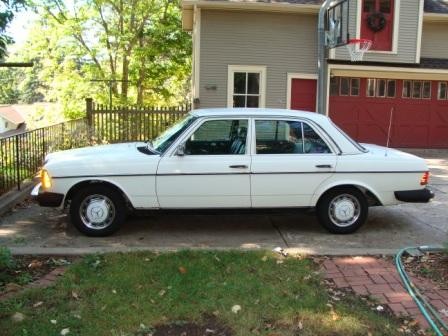The year was 2008. Our family was down to a single vehicle after our VW Passat’s unexpected retirement. Navigating life with one car in the city was manageable, a mix of minivan usage, public transport, and ride-sharing. But when I shifted gears to launch a consulting business that fall, a new car purchase wasn’t in the cards financially. That’s when I stumbled upon an article in the New York Times about the legendary Mercedes W123 diesel models. A lightbulb went off. Here was my chance to own a classic car and solve my daily driver needs simultaneously. Like others who had considered this on Curbside Classic, I was drawn to the promise of indestructible reliability. And so, a white 1983 Mercedes-Benz 240D entered my life.
Looking back, buying this 26-year-old Mercedes in January in Minnesota wasn’t my most calculated move. Winter in the Midwest isn’t exactly ideal car-shopping weather. The selection was, to put it mildly, thin. While I admired the W123’s reputation and timeless design, my actual experience was zero. Never driven one, only a brief 10-minute ride years ago in a friend’s parents’ W123. And let’s face it, cars of that age come with baggage. Reasonable expectations and a thorough inspection were crucial. However, the car was on Craigslist, located on a farm two hours away. Inspection opportunities were limited by distance, time, and the biting Minnesota cold. Adding to the charm was the engine: the infamous four-cylinder Mercedes diesel. A workhorse, undoubtedly, but also notoriously slow. Oh, and it had an automatic transmission. Starting a 26-year-old diesel in sub-freezing temperatures requires a unique brand of patience, though thankfully, it did have a block heater.
After persuading my family to join a 100-mile trek to a southern Minnesota farm, I met the friendly young seller and, without excessive deliberation, handed over $2200 for the 240D. These cars are built like tanks, incredibly solid with vault-like construction. This particular model clocked around 170,000 miles, which, for a Mercedes diesel of this era, felt like it was just getting warmed up. The ride was smooth, surprisingly quiet, and at cruising speed, it ran effortlessly. However, the drive home revealed some quirks. The dashboard lights were dimmer than a firefly – reading the speedometer at night was a challenge. The heater was a slow starter, taking its sweet time to generate warmth. And winter traction reminded me it had been a while since I drove a rear-wheel-drive car. Despite decent Michelin tires, I quickly recalled the difference drive wheels make on snow and ice.
The Mercedes 240D was undeniably robust, but age takes its toll on any vehicle. Within the first month, the oil cooler lines decided to stage a dramatic leak, demanding replacement to the tune of nearly $1,000. The notorious Mercedes vacuum system also lived up to its reputation for erratic behavior. Door locks became a lottery – sometimes they opened, sometimes not, governed by some automotive voodoo I couldn’t decipher. I even invested in diagnostic tools to tackle the vacuum gremlins, with minimal success. My grade-school sons developed a chorus of complaints about being trapped in the back seat due to malfunctioning door locks.
Winter driving brought its own set of anxieties. Having never owned a diesel in a frigid climate, I became fixated on whether the car would start, constantly worrying about venturing out without plugging in the block heater. The glow plugs performed their duty, and I never got stranded, but the apprehension was always present in sub-freezing conditions. Finally, the non-functional A/C meant defrosting and defogging could be a hit-or-miss affair, adding another layer of complexity to winter driving.
However, the most significant drawback was the car’s leisurely pace. For city driving, it was manageable. Once you reached cruising speed, it kept up with traffic. Handling was respectable, and I quickly re-acclimated to the nuances of rear-wheel drive in winter. But highway merging became a strategic exercise. Every on-ramp required careful planning – needing a long merge lane and no vehicles approaching in the right lane. Most of the time, it worked out, but the margin for error was slim. The automatic transmission shifted smoothly and worked harmoniously with the engine; the issue was simply a lack of horsepower relative to the car’s weight. Adding passengers amplified the drama, making highway entries feel a bit too precarious.
Despite these challenges, the 240D possessed undeniable virtues. With more time, resources, and expertise, I could have truly made it work. The W123 chassis might be perceived as staid, but its design is timeless, and Mercedes undeniably over-engineered these cars. It’s no surprise I later encountered countless W123s as taxis during travels in Morocco. Excellent space utilization, robust build quality, a comfortable yet controlled ride, and fundamentally sound systems made it ideal for long-term use, particularly in warmer climates.
Ultimately, the Mercedes 240D didn’t quite fulfill its role as a dependable backup family car. As warmer weather arrived, my car gaze started to drift, and by September, I was eyeing another classic rear-wheel-drive replacement – this time a blue Volvo 240 wagon. After a few weeks on Craigslist, I sold the 240D to a couple from a farm north of the Twin Cities. Perhaps there was a natural synergy between rural life and these enduring, if slow, Mercedes diesels.
Now that empty-nesterhood is on the horizon, the idea of another W123 diesel, purely as a fair-weather classic, resurfaces. If I were to revisit the W123, I’d likely seek out the turbo five-cylinder or, at minimum, a four-cylinder paired with a manual transmission. Even four decades after their debut, these cars retain a remarkably handsome presence. Seeing wagon versions in my neighborhood sparks the thought, “Maybe someday…”
